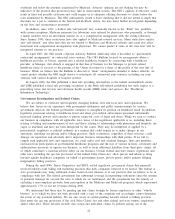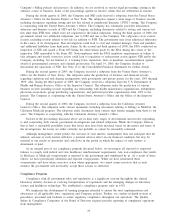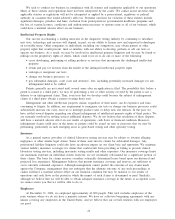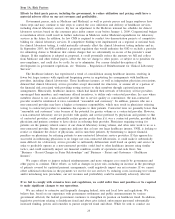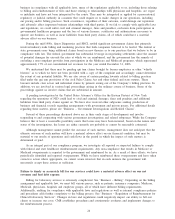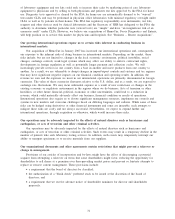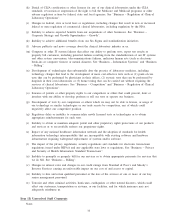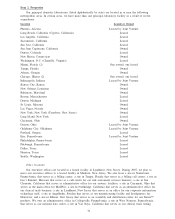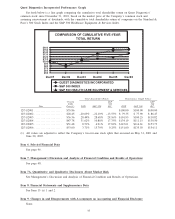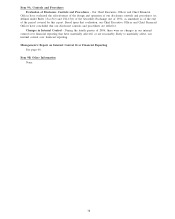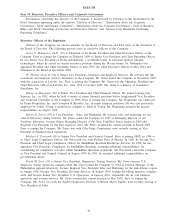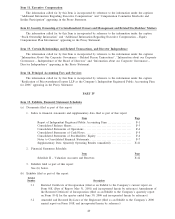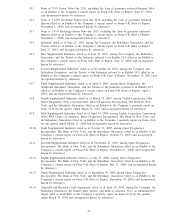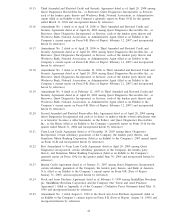Quest Diagnostics 2006 Annual Report Download - page 53
Download and view the complete annual report
Please find page 53 of the 2006 Quest Diagnostics annual report below. You can navigate through the pages in the report by either clicking on the pages listed below, or by using the keyword search tool below to find specific information within the annual report.CAUTIONARY STATEMENT FOR PURPOSES OF THE “SAFE HARBOR” PROVISIONS OF THE
PRIVATE SECURITIES LITIGATION REFORM ACT OF 1995
Some statements and disclosures in this document are forward-looking statements. Forward-looking
statements include all statements that do not relate solely to historical or current facts and can be identified by
the use of words such as “may”, “believe”, “will”, “expect”, “project”, “estimate”, “anticipate”, “plan” or
“continue”. These forward-looking statements are based on our current plans and expectations and are subject to
a number of risks and uncertainties that could significantly cause our plans and expectations, including actual
results, to differ materially from the forward-looking statements. The Private Securities Litigation Reform Act of
1995, or the Litigation Reform Act, provides a “safe harbor” for forward-looking statements to encourage
companies to provide prospective information about their companies without fear of litigation.
We would like to take advantage of the “safe harbor” provisions of the Litigation Reform Act in connection
with the forward-looking statements included in this document. Investors are cautioned not to unduly rely on such
forward-looking statements when evaluating the information presented in this document. The following important
factors could cause our actual financial results to differ materially from those projected, forecasted or estimated
by us in forward-looking statements:
(a) Heightened competition, including increased pricing pressure, competition from hospitals for testing for
non-patients and competition from physicians. See “Business – Competition”.
(b) Impact of changes in payer mix, including any shift from fee-for-service to capitated fee arrangements.
See “Business – Payers and Customers – Healthcare Insurers”.
(c) Adverse actions by government or other third-party payers, including unilateral reduction of fee
schedules payable to us, competitive bidding, an increase in the practice of negotiating for exclusive
arrangements that involve aggressively priced capitated or fee for service payments by healthcare
insurers or other payers and threats by third party payers against physicians and patients that effectively
eliminate their choice to use an out-of-network provider under PPO and similar plans. See “Business –
Recent Changes in Payer Relationships”, “Business – Regulation of Reimbursement for Clinical
Laboratory Services” and “Business – Payers and Customers – Healthcare Insurers”.
(d) The impact upon our testing volume and collected revenue or general or administrative expenses
resulting from our compliance with Medicare and Medicaid administrative policies and requirements of
third party payers. These include:
(1) the requirements of Medicare carriers to provide diagnosis codes for many commonly ordered tests
and the possibility that third party payers will increasingly adopt similar requirements;
(2) the policy of CMS to limit Medicare reimbursement for tests contained in automated chemistry
panels to the amount that would have been paid if only the covered tests, determined on the basis
of demonstrable “medical necessity”, had been ordered;
(3) continued inconsistent practices among the different local carriers administering Medicare;
(4) inability to obtain from patients an advance beneficiary notice form for tests that cannot be billed
without prior receipt of the form;
(5) the potential need to monitor charges and lower certain fees to Medicare to comply with the OIG’s
proposed rule pertaining to exclusion of providers for submitting claims to Medicare containing
charges that are substantially in excess of the provider’s usual charges; and
(6) increased challenges in operating as a non-contracted provider with respect to healthcare insurers.
See “Business – Recent Changes in Payer Relationships”, “Business – Regulation of Reimbursement for
Clinical Laboratory Services” and “Business – Billing”.
(e) Adverse results from pending or future government investigations, lawsuits or private actions. These
include, in particular significant monetary damages, loss or suspension of licenses, and/or suspension or
exclusion from the Medicare and Medicaid programs and/or criminal penalties. See “Business –
Government Investigations and Related Claims”.
(f) Failure to efficiently integrate acquired businesses, and to manage the costs related to any such
integration, or to retain key technical and management personnel. See “Business – Corporate Strategy
and Growth Opportunities – Growth”.
(g) Inability to obtain professional liability or other insurance coverage or a material increase in premiums
for such coverage or reserves for self-insurance. See “Business – Insurance”.
32


